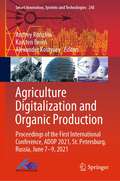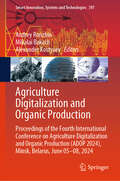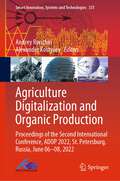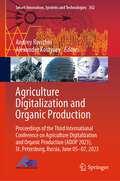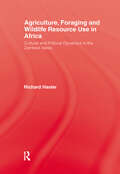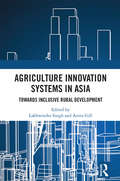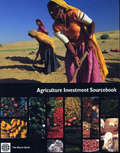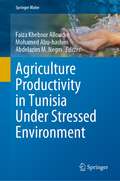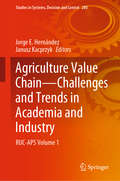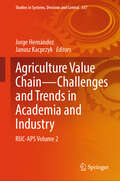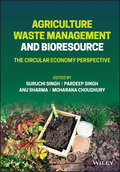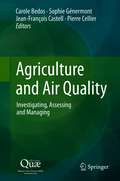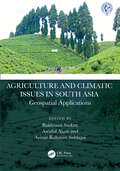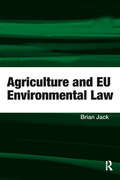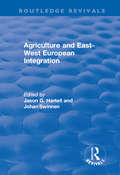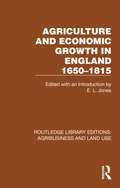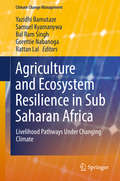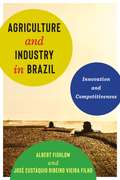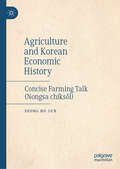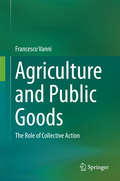- Table View
- List View
Agriculture Digitalization and Organic Production: Proceedings of the First International Conference, ADOP 2021, St. Petersburg, Russia, June 7–9, 2021 (Smart Innovation, Systems and Technologies #245)
by Andrey Ronzhin Karsten Berns Alexander KostyaevThis book features selected papers presented at the First International Conference on Agriculture Digitalization and Organic Production (ADOP 2021), held in St. Petersburg, Russia, on June 07–09, 2021. The contributions, written by professionals, researchers and students, cover topics in the field of agriculture, biology, robotics, information technology and economics for solving urgent problems in digitalization of organic livestock and crop production. The conference is organized by the St. Petersburg Federal Research Center of the Russian Academy of Sciences (SPC RAS) and the Technische Universitat Kaiserslautern.The book will be useful to researchers of interdisciplinary issues of digitalization and robotization of agricultural production, as well as farmers and commercial companies, which introduce new technologies in crop production and animal husbandry. The book also covers a range of issues related to scientific training of graduate students in the areas of "Mechatronics and robotics", "Control in technical systems" and "Technologies, means mechanization and energy equipment in rural, forestry and fisheries”.
Agriculture Digitalization and Organic Production: Proceedings of the Fourth International Conference on Agriculture Digitalization and Organic Production (ADOP 2024), Minsk, Belarus, June 05-08, 2024 (Smart Innovation, Systems and Technologies #397)
by Andrey Ronzhin Alexander Kostyaev Mikalai BakachThis book includes selected papers from the Fourth International Conference on Agriculture Digitalization and Organic Production (ADOP 2024), held in Minsk, Belarus during June 05–08, 2024. The topics covered in the book are ground robotic systems in crop production, unmanned aerial vehicles in crop production, aerospace monitoring tools in crop production, robotic animal husbandry, digitalization of technological processes of agricultural production, evaluation of the effectiveness of digital technologies for the production of organic products, rational nature management and ecology in agricultural production, technologies for the production of organic agricultural products, market analysis of organic agricultural products and legal aspects of organic production.
Agriculture Digitalization and Organic Production: Proceedings of the Second International Conference, ADOP 2022, St. Petersburg, Russia, June 06–08, 2022 (Smart Innovation, Systems and Technologies #331)
by Andrey Ronzhin Alexander KostyaevThis book includes selected papers from the Second International Conference on Agriculture Digitalization and Organic Production (ADOP 2022), held in St. Petersburg, Russia, during June 06–08, 2022. The topics covered in the book are ground robotic systems in crop production, unmanned aerial vehicles in crop production, aerospace monitoring tools in crop production, robotic animal husbandry, digitalization of technological processes of agricultural production, evaluation of the effectiveness of digital technologies for the production of organic products, rational nature management and ecology in agricultural production, technologies for the production of organic agricultural products, market analysis of organic agricultural products, and legal aspects of organic production.
Agriculture Digitalization and Organic Production: Proceedings of the Third International Conference on Agriculture Digitalization and Organic Production (ADOP 2023), St. Petersburg, Russia, June 05–07, 2023 (Smart Innovation, Systems and Technologies #362)
by Andrey Ronzhin Alexander KostyaevThis book includes selected papers from the Third International Conference on Agriculture Digitalization and Organic Production (ADOP 2023), held in St. Petersburg, Russia, during June 05–07, 2023. The topics covered in the book are ground robotic systems in crop production, unmanned aerial vehicles in crop production, aerospace monitoring tools in crop production, robotic animal husbandry, digitalization of technological processes of agricultural production, evaluation of the effectiveness of digital technologies for the production of organic products, rational nature management and ecology in agricultural production, technologies for the production of organic agricultural products, market analysis of organic agricultural products and legal aspects of organic production.
Agriculture Foraging & Wildlife
by HaslerFirst Published in 1996. Routledge is an imprint of Taylor & Francis, an informa company.
Agriculture Geography First Semester FYBA, B.COM, B.SC New NEP Syllabus - SPPU
by Dr Jyotiram C. More Prof. Harishchandra S. Timbole Dr Ganesh Madhukar DhawaleThe book titled "Agriculture Geography" provides a comprehensive overview of agricultural geography, its principles, and its importance. It begins with the definition and scope of agricultural geography, examining the spatial relationships between agriculture and human activities. The text discusses the various types of agriculture, including subsistence, commercial, and mixed farming, as well as modern trends like smart and natural farming. It explores the physical and economic factors influencing Indian agriculture, highlights the historical and geographical transformations in agricultural practices, and addresses the impact of agricultural revolutions like the Green, White, and Blue Revolutions. The book also covers government policies, technological advancements, and new perspectives aimed at achieving sustainable agriculture, ensuring food security, and improving farmer incomes. Designed as a textbook for students, it combines theoretical knowledge with practical insights, supported by exercises and examples for academic and competitive examinations.
Agriculture In Third Wrl/h
by W. B. Morgan... we do not yet seem to have realised that the exchange of products between countries in one part of the world but at different stages of development is no less natural, and no less profitable for the various nations, than the exchange of products which differ because they grow in different climates' (Thiinen-Hall, xg66, p. 194). There have been few attempts to study agriculture within a spatial framework, notwithstanding the quintessential importance of land as a production factor. Land is most often treated as generalized environment although it could also be considered as social and economic space-social because even the most crowded of farming communities has much greater distance between its basic social units than exist within an urban-industrial agglomeration, and economic because distances to markets, to factor sources and to information must be overcome and frequently vary by type of market, factor and information source. Modem agricultural geography has been largely preoccupied with the development of techniques and with classification, often as ends in thexnselves, or with a geographical element consisting mainly of some general locational reference or regional description. Rarely has there been an attempt to identify a spatial structure associated with some particular agricultural enterprise* or practice.
Agriculture Innovation Systems in Asia: Towards Inclusive Rural Development
by Lakhwinder Singh Anita GillThis book looks at agricultural systems and rural economies in Asia through the prism of alternative innovation systems, alternative public policy and institutional changes. The massive shifts within the agricultural economy in Asia, geared towards increasing production, has had a direct effect on the livelihood of a large mass of people in rural societies, causing financial and social distress. This book explores a wide range of solutions, such as the role of education, improving technical skills and human capital, along with interactive learning in R&D, harnessing ICTs and institutional innovations, to see how these problems can be alleviated. The volume looks at how these methods can help formulate alternative ways to build sustainable and inclusive agricultural societies, ensure food security, sustainable growth and agricultural productivity. This book, rich in theoretical and empirical matter, will be useful for academics and researchers interested in agricultural innovation, development studies and agricultural economics. It will also be of interest to policymakers and thinktanks working towards inclusive social development and sustainability in Asia and the Indian subcontinent.
Agriculture Investment Sourcebook
by World BankInvesting to promote agricultural growth and poverty reduction is a central pillar of the World Bank's current rural strategy, 'Reaching the Rural Poor' (2003). This 'Sourcebook' addresses how to implement the rural strategy, by sharing information on investment options and identifying innovative approaches that will aid the design of future lending programs for agriculture. It provides generic good practices and many examples that demonstrate investment in agriculture can provide rewarding and sustainable returns to development efforts. It is divided into eleven self-contained modules. Each module contains three different types of subunits that can also be stand-alone documents: I. Module Overview II. Agricultural Investment Notes III. Innovative Activity Profiles. The stand-alone nature of the subunits allows flexibility and adaptability of the material. Selected readings and web links are also provided for readers who seek more in-depth information. The 'Sourcebook' draws on a wide range of experiences from donor agencies, governments, institutions, and other groups active in agricultural development. It is an invaluable reference tool for policy makers, professionals, academics and students, and anyone with an interest in agricultural investments.
Agriculture Productivity in Tunisia Under Stressed Environment (Springer Water)
by Abdelazim M. Negm Mohamed Abu-Hashim Faiza Khebour AlloucheThis book highlights recent efforts to sustain agricultural productivity in Tunisia under a stressed environment and aridity conditions. This book's authors gathered a unique set of applications and approaches, including techniques applied to increase yield and preserve the environment, such as organic farming and using biochar amendment and its effects on soils' physicochemical properties. This book also presents water resources management and water management practices for sustainable soil production, diagnosis, and new farming technologies to enhance water-use efficiency. The book also addresses current livestock strategies intended to maintain production sustainability, increase fish productivity, and initiatives for sustainable tourism development.Given its scope, the book offers a valuable guide for policy planners, decision-makers, stakeholders, researchers, and graduate students in Tunisia and neighboring countries with similarly stressed environmental conditions.
Agriculture Science And Technology class 11 - Maharashtra Board
by Maharashtra State Bureau of Textbook Production and Curriculum ResearchCreated by the Maharashtra State Bureau of Textbook Production and Curriculum Research, this textbook is for the students appearing for class 11 examinations. This text book covers various topics related to Agriculutal science and technology. It serves as a source of information covering maximum aspects, which can help students understand the topics with eagerness to study further higher courses.
Agriculture Value Chain - Challenges and Trends in Academia and Industry: RUC-APS Volume 1 (Studies in Systems, Decision and Control #280)
by Jorge E. Hernández Janusz KacprzykThis book is the first volume in a collection of contributions arising from a multidisciplinary project developed in the field of agri-food value chain analysis. The respective papers combine a range of disciplines to analyse major agri-food challenges in Europe and South America, offering readers a practical understanding of how risk and uncertainties can be managed by means of validated data and results from agri-food systems analysis. Experts from agronomy, information communication and technology, operations and supply chain management share their findings and propose novel approaches. Given its scope, the book will be of interest to a broad readership who want to learn about current agri-food challenges and requirements, and to professionals whose work involves real-life industry requirements, food and/or farming.
Agriculture Value Chain — Challenges and Trends in Academia and Industry: RUC-APS Volume 2 (Studies in Systems, Decision and Control #557)
by Janusz Kacprzyk Jorge HernándezThis book stands as a significant milestone in the realm of agricultural research and innovation, representing the comprehensive efforts of the RUC-APS Project. The RUC-APS Project, officially known as "Enhancing and Implementing Knowledge-Based ICT Solutions Within High-Risk and Uncertain Conditions for Agriculture Production Systems," was a collaborative initiative under the H2020 European Framework, running from October 3, 2016, to April 2, 2022. Spearheaded by the esteemed Prof. Jorge Hernández, formerly of the University of Liverpool, UK, and currently affiliated with Universidad Adolfo Ibañez, Santiago de Chile, the project brought together a consortium of 16 participants from 5 EU countries and 3 partners from 2 third countries. This book marks the culmination of rigorous research and insights garnered through a meticulous peer-review process involving contributions from various RUC-APS international conferences held between 2021 and 2023. It delves into the pressing need to address the challenges faced by modern agricultural systems, particularly agricultural value chains, amidst volatile and uncertain environmental conditions. The ever-changing landscape of resources, coupled with factors like unpredictable weather patterns, pest infestations, market fluctuations, and fluctuating commodity prices, necessitates a holistic and adaptive approach to ensure resilience and sustainability across the agricultural value chain. Navigating these complexities requires informed decision-making processes that account for risks throughout the entire agricultural lifecycle. The complexity of these decision-making paradigms underscores the critical importance of this book and the insights gleaned from the RUC-APS Project. By shedding light on multifaceted challenges and proposing innovative solutions, this collaborative effort aims to pave the way for a more resilient and sustainable agricultural landscape.
Agriculture Waste Management and Bioresource: The Circular Economy Perspective
by Pardeep Singh Suruchi Singh Anu Sharma Moharana ChoudhuryAGRICULTURE WASTE MANAGEMENT AND BIORESOURCE Comprehensive resource detailing the generation of agricultural waste and providing insight into waste management Agriculture Waste Management and Bioresource provides thorough coverage of the generation of agricultural waste with essential thought leadership about various options in managing the waste, including composting, vermicomposting to form manure, and biogas generation. Readers take a crucial step toward more sustainable development and creating a greener planet. The text includes a wide range of information regarding resource recovery from the waste of the agriculture sector, energy generation, biofuels, reduction in the amount and volume of waste through circular economies, and much more. The authors place particular importance on understanding and managing agricultural waste concerning the sustainability of the environment in the era of global climate change. Topics covered in Agriculture Waste Management and Bioresource include: Categories and amounts of agricultural wastes seen in a worldwide perspective and current challenges and perspectives in handling agricultural wastes State-of-the-art processing technologies relevant for agricultural wastes categories and sustainable methods used for management of agricultural??biomass Bioethanol production from lignocellulose waste of agricultural waste biomass and biogas production through anaerobic digestion of agricultural wastes Mechanical and chemical processing, aerobic and anaerobic treatment, other biological processing methods, and thermal processing Academics, students, and industry professionals in environmental science and engineering, waste management, and agriculture can use the valuable insights in Agriculture Waste Management and Bioresource to understand the latest in the field and the advancements that can propel us towards a better and more sustainable future.
Agriculture and Air Quality: Investigating, Assessing and Managing
by Carole Bedos Sophie Génermont Jean-François Castell Pierre CellierThis book gives an overview of the relationships between agriculture and air quality, which is an issue of increasing importance for practitioners and policy makers. It provides the keys to understand natural and anthropogenic mechanisms governing emission and deposition of pollutants produced by and/or impacting agricultural activitiesIt identifies how management practices can help mitigating emissions and how public policies on air pollution progressively addressed the agricultural sectorThis book was written for students, researchers and agriculture actors as well as for public decision-makers
Agriculture and Climatic Issues in South Asia: Geospatial Applications
by Asraful Alam Azizur Rahman Siddiqui Rukhsana SarkarThis book presents focussed information related to dynamic cropland transformation, agriculture development, climate change, and environment with the application of advance geospatial technology. It describes research using geospatial tools and techniques to develop the models, design, and planning for agricultural land use optimization especially in south Asian countries. It covers agriculture production, water scarcity, industrial development, natural resources, environmental degradation, and sustainable development.Features: Provides the adaptation strategy from a multidisciplinary resilience perspective Addresses contemporary agricultural resilience to various climate change issues Develops novel approaches for sustainability with environmentally sound practices Discusses methodological and innovative approaches at local to global perspective Reports research using geospatial tools and techniques to develop the models, design, and planning for agricultural land use optimization The book is aimed at researchers, professionals, and graduate students in GIS, environmental engineering, geography, agriculture, and climate studies.
Agriculture and EU Environmental Law
by Brian JackThis book critically examines the development and current structure of European Union agri-environmental measures at a substantive level. Examining the measures in an integrated manner, showing how they interrelate linking different aspects of European Union agricultural law and policy, this volume examines the legislation adopted at European Union level as well as the impact of particular national measures to implement that legislation. Where appropriate, comparisons are drawn between the manner in which European Union legislation has been implemented among various Member States. Critically assessing European Union and national measures, in the light of other policy pressures such as the influence of world trade agreements and the political pressures exerted by the agricultural sector within the national legal systems of individual Member States, this volume is a valuable resource for academics researching and practitioners working in the areas of European Union environmental and agricultural law.
Agriculture and East-west European Integration
by JASON G. HARTELL, JOHAN F.M. SWINNENThis title was first published in 2000: This volume analyzes key issues of the process of integrating Central and Eastern European countries with the European Union related to agriculture. The issues include the comparative advantage of CEEC agriculture and its development under various accession policy scenarios; the likely policy developments in both the CEECs and the EU, based on economic, social and political economy considerations; the expected economic impacts and adjustment costs for the agro-food sector under various policy outcomes; the most important constraints for integration including policy convergence issues and internal constraints; and how integration will potentially affect trade and labour flows in the Union. The country combines detailed country-specific and region-wide empirical and theoretical analysis.
Agriculture and Economic Development in East Asia: From Growth to Protectionism in Japan, Korea and Taiwan (Esrc Pacific Asia Ser.)
by Penelope Francks Joanna Boestel Choo Hyop KimA comparative study which describes and analyses the contribution of agriculture to the economies of East Asia. Until now, little attention has been paid to the agricultural sector which actually underpins industrial and commercial development. Recently, this sector has become the focus of increasingly bitter economic disputes, especially over protection and the use of import tariffs. A comparative framework is used, employing case studies from Japan, Taiwan and South Korea to highlight both the common characteristics of agriculture's role in East Asian development, and features particular to the political economy of agriculture in each country.
Agriculture and Economic Development in Europe Since 1870 (Routledge Explorations in Economic History)
by Pedro Lains Vicente PinillaWhilst many books on the European economy have focused on the analysis of its industrial sectors, this book draws attention to the often ignored contribution made by the development of European agriculture over the past two centuries. In doing so, the authors adopt a revisionist perspective on the subject, addressing the lack of coherent study of the agricultural sector and reassessing old theories about the links between agricultural and economic development. In focusing on those countries which by 1870 still had a large agricultural sector, namely, France, Germany, Italy, Denmark, The Netherlands, Sweden, Spain, Portugal, Poland, Hungary, Greece and Turkey, this book determines the role of the agricultural sector in the economic development of Europe. These chapters demonstrate how the rate of development in the agricultural sector depended on specific industrial, political and market conditions; the diversity of ways and timings through which transformation was achieved is also considered.
Agriculture and Economic Growth in England 1650-1815 (Routledge Library Editions: Agribusiness and Land Use #15)
by E. L. JonesOriginally published in 1967, this was the first book to discuss why agricultural supply became more ‘responsive’ and to provide broadly based evidence of the ways in which that ‘responsiveness’ may have influenced the growth of the economy. The editor chose 7 essays, reprinted in full, to illustrate altered perspectives of agricultural change. His substantial introduction places the beginnings of a significant rise in farm output as far back as the mid-seventeenth century and concludes that agriculture played a vital but complicated role in the economy of eighteenth-century England.
Agriculture and Ecosystem Resilience in Sub Saharan Africa: Livelihood Pathways Under Changing Climate (Climate Change Management)
by Rattan Lal Bal Ram Singh Yazidhi Bamutaze Samuel Kyamanywa Gorettie NabanogaThis volume discusses emerging contexts of agricultural and ecosystem resilience in Sub Saharan Africa, as well as contemporary technological advances that have influenced African livelihoods. In six sections, the book addresses the sustainable development goals to mitigate the negative impacts on agricultural productivity brought about by climate change in Africa. Some of the challenges assessed include soil degradation, land use changes, natural resource mismanagement, declining crop productivity, and economic stagnation. This book will be of interest to researchers, NGOs, and development organizations.Section 1 focuses on climate risk management in tropical Africa. Section 2 addresses the water-ecosystem-agriculture nexus, and identifies the best strategies for sustainable water use. Section 3 introduces Information Communication Technology (ICT), and how it can be used for ecosystem and human resilience to improve quality of life in communities. Section 4 discusses the science and policies of transformative agriculture, including challenges facing crop production and management. Section 5 addresses landscape processes, human security, and governance of agro-ecosystems. Section 6 concludes the book with chapters uniquely covering the gender dynamics of agricultural, ecosystem, and livelihood resilience.
Agriculture and Industry in Brazil: Innovation and Competitiveness
by Albert Fishlow José Eustáquio Vieira FilhoAgriculture and Industry in Brazil is a study of the economics of Brazilian agriculture and industry, with a special focus on the importance of innovation to productivity growth. Albert Fishlow and José Eustáquio Ribeiro Vieira Filho examine technological change in Brazil, highlighting the role of public policy in building institutions and creating an innovation-oriented environment.Fishlow and Vieira Filho tackle the theme of innovation from various angles. They contrast the relationship between state involvement and the private sector in key parts of the Brazilian economy and compare agricultural expansion with growth in the oil and aviation sectors. Fishlow and Vieira Filho argue that modern agriculture is a knowledge-intensive industry and its success in Brazil stems from public institution building. They demonstrate how research has played a key role in productivity growth, showing how prudent innovation policies can leverage knowledge not only within a particular company but also across whole sectors of the economy. The book discusses whether and how Brazil can serve as a model for other middle-income countries eager to achieve higher growth and a more egalitarian distribution of income. An important contribution to comparative, international, and development economics, Agriculture and Industry in Brazil shows how the public success in agriculture became a prototype for advance elsewhere.
Agriculture and Korean Economic History: Concise Farming Talk (Nongsa chiksǒl)
by Seong Ho JunThis book is an economic history of the Chosŏn dynasty (1392-1910). The Chosŏn dynasty is not only known for managing the northeastern regions of Asia for 500 years as the exemplars of Confucianism, their kingdom was also one of the greatest so-called “agricultural states under Heaven.” The Chosŏn dynasty has been briefly explored academically by Western scholars, but their findings have some limitations. The period of 1400-1600, in particular, has been too poorly reported on in the English language to gain the attention of the Western knowledge society. This book aims to fill the gaps in the existing research and will be of interest to economists, scholars of Korean history, agriculturists, and ecologists.
Agriculture and Public Goods: The Role of Collective Action
by Francesco VanniThe debate on the future orientation of the EU Common Agricultural Policy (CAP) is increasingly shaped by the role of agriculture in providing public goods, and there is a broad consensus that this approach will be particularly relevant in legitimating the policy intervention in agriculture in the future. In the context of this debate, it is not clear to what extent collective action could be taken into consideration as a valuable alternative to market or state regulation in contributing to the provision of public goods, and to what extent it is possible to design and implement agricultural policies that incorporate a collective and collaborative approach between different stakeholders in rural areas. Through an in depth analysis two case studies in Italy, the book provides insights to both the policy and the theoretical debate on the role of collective action for the public goods associated to agriculture.
